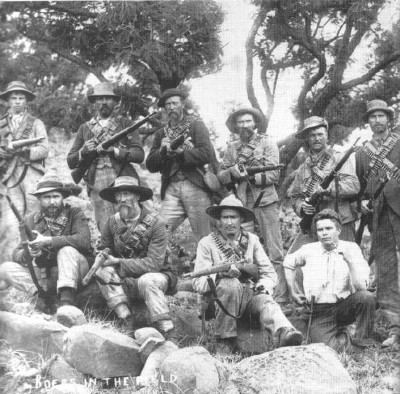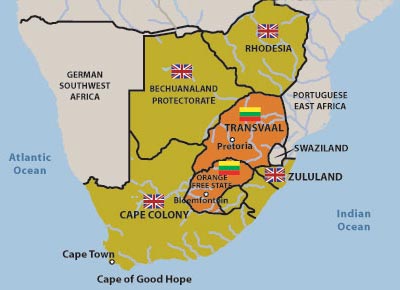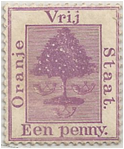ALBUM – view my Orange Free State album
TRANSITION CHART – for the South Africa Area
Fast Facts
Region: Southern Africa
Group: South Africa Area
Classification: Boer Republic
Prior Regime: Orange River Sovereignty (British)
Key Dates:
1652, Apr 6 – First Dutch settlements in the Cape Area
1854, Feb 23 – Orange Free State recognized as independent Republic
1869 – Diamonds discovered in Orange Free State
1899, Oct 11 – Second Boer War breaks out
1902, May 31 – Orange Free State annexed by Great Britain to become Orange River Colony.
Following Regime: Orange River Colony (British)
Scott Catalogue: (Orange River Colony) #1-43
Pick Catalogue: Postal Orders – #PS681-PS689
History

The Dutch were the first Europeans to settle the Cape area of Africa in the mid 1600s, where the Dutch East India Company, (Vereenigde Oostindische Compagnie, or VOC) built a resupply station for its ships between India and Europe. Gradually the Dutch colony in South Africa expanded and in 1688, French Huguenots arrived fleeing religious persecution. Slowly the native people were driven from their land and in 1713 many died in a smallpox epidemic.
In 1814, the British took full control of the Cape Colony area and British settlers began to arrive. The Boers (Dutch settlers) in the region resented British rule and eventually began a mass migration north, in what was called the Great Trek. In 1838 the Boers fought and defeated the Zulus at the battle of Blood River and eventually founded several republics, most notably Orange Free State and the South Africa Republic (ZAR), which later became Transvaal.
 Orange Free State, was officially recognized in 1854, and built a successful republic, which was recognized by many Western European nations including Great Britain as well as the United States. The fortunes of the Republic significantly changed in 1867, when diamonds were discovered. This stimulated a rush of thousands of fortune hunters as well as keen interest from the British. By the early 1870’s, diamonds were a mainstay of the Orange Free State’s income.
Orange Free State, was officially recognized in 1854, and built a successful republic, which was recognized by many Western European nations including Great Britain as well as the United States. The fortunes of the Republic significantly changed in 1867, when diamonds were discovered. This stimulated a rush of thousands of fortune hunters as well as keen interest from the British. By the early 1870’s, diamonds were a mainstay of the Orange Free State’s income.
Increasingly the British were determined to bring all of South Africa, including the Boer republics under their control. The United Kingdom begin expanding their control in the region, plotting with British settlers within the ZAR to incite a rebellion, in 1895, which was supported militarily. The Boer Republics allied together and captured the troops supported by the British and ended the rebellion. Finally in October 1899 war broke out in South Africa between the Boers and the British. At first the Boers were successful but in 1900 as additional British troops arrived and the Boers were pushed back, the British begin taking Orange Free State lands, and the Boers turned to guerrilla warfare. In a sad note in British History, the British commander, Herbert Kitchener, began herding Boer women and children into concentration camps where more than 20,000 of them died of disease. The Boers surrendered in 1902, and Orange Free State was annexed by Great Britain, and became Orange River Colony. Orange River Colony, joined other colonies in 1910 to form the Union of South Africa.
Stamps
 ALBUM
ALBUM
Although Orange Free State issued only one design for its stamps, the orange tree with 3 post horns, the multitude of changes and varieties of overprints make it a very interesting country to collect. The first stamps were issued in 1868 in three denominations: 1p, 6p and 1s. In 1878 and 1883, additional denominations were added to reflect reductions in postal rates, and in the late 1890s stamps were reprinted in different colors. Overall 8 separate denominations were issued, many of them in two different colors.
In 1900, as the British began occupying Free State’s lands, the stamps were overprinted “V.R.I” (Victoria Regina Imperatrix). “V.R.I.” overprints had to be applied to postage, revenue and telegraph stamps, leading to a complex series of settings and numerous varieties.
What really makes Orange Free State an interesting area to collect are the various surcharge varieties. Because the stamps were printed in London, many months elapsed between the date of ordering new stocks and their arrival in the Free State. In the meantime, surplus stocks of other values were overprinted with the new denominations. Various local printers were used, and although the quality was high, the variations in surcharges provide many different varieties, including occasional inverts, double prints or other types of defects.
Banknotes
The Orange Free State pound, known as “bluebacks” was used prior to the end of the Second Boer War. Like the South African Republic pound, it was divided into 20 Shillings or 240 Pence. It was withdrawn in 1902 and replaced by the Orange River Colony pound, which was in turn withdrawn in 1910 and replaced by the Orange Free State pound.
The Orange Free State and the South African Republic were the first countries in the world to declare postal orders to be legal tender as an emergency currency. At this time, it is currently difficult to distinguish between the currency issues and the normal postal notes. Postal orders of the Orange Free State were introduced on 1 January 1898. They came in a range of denominations from 1 Shilling to 1 Pond. The Orange Free State’s postal orders were known in Afrikaans as Post Noot (or Postal Note). The Orange Free State postal notes are inscribed in Afrikaans, even though the Orange Free State’s name is given in the Dutch spelling – ‘ORANJE VRIJ STAAT’, which also appears in the watermark.
Links
Orange Free State – Wikipedia
Orange Free State Study Circle
Postal Orders of Orange Free State




